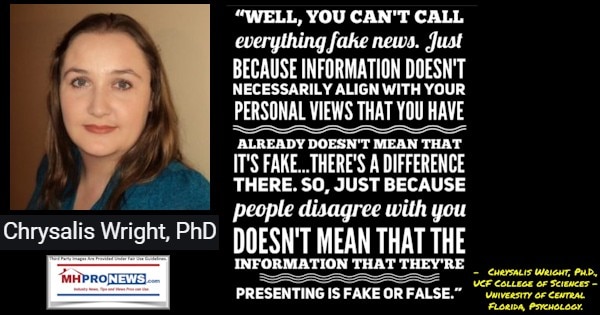
The email from the Manufactured Housing Institute (MHI) to their email readers on September 15, 2021 had no mention of the looming Department of Energy (DOE) rule which have been described as “costly,” burdensome, and not cost-beneficial. These DOE rules could hit manufactured housing producers, sellers, and consumers in the near term if the movement for their enactment is not abated. Nor did that MHI emailed message mention the upcoming Manufactured Housing Consensus Committee (MHCC) meeting that will be engaged in discussions about that DOE energy rule and related concerns. Nevertheless, that same MHI email strutted anew with their brash and apparently gross self-promoting claim “Learn, Grow and Succeed in Manufactured Housing.” By contrast, their smaller production-focused rival trade group’s 9.15.2021 email to MHProNews stated that attached “are initial comments submitted by the Manufactured Housing Association for Regulatory Reform (MHARR) to the federal Manufactured Housing Consensus Committee (MHCC) in connection with the MHCC’s upcoming September 23, 2021 meeting to consider – and provide comments on – the latest U.S. Department of Energy (DOE) proposed “energy conservation” standards for manufactured housing.” Substance in the later, self-promotion in the former is one possible takeaway. As important, the DOE rule sucks big dirty rocks on several arguably corrupt levels.
But to focus for now on the rival trade groups, there are two other sets of takeaways from the above. Because right or wrong, each organization reveals something the other national manufactured housing trade group might learn from their competitor.
- MHARR can learn from MHI that each message could include a link to their accomplishments and a link to their brief history/objectives and call to action to become a member/join MHARR page. Their larger rivals make a similar pitch routine, despite the fact that MHI is “bereft” of measurable results for the industry’s independents.
- If MHI leaders are sincere in their desire to see the industry at large “Grow and Succeed,” as they recently claimed in more detail, then MHI could learn to stop posturing and start doing the job that they allege doing on behalf of “all segments” of manufactured housing. MHI could also learn to post every email they send to members/readers on MHI’s own website, as MHARR does. Doing so would create a readily available history of their claims which could foster accountability. But instead, in recent years much of what MHI does is obscured and apparently deliberately hidden unless it is gathered by a third-party, published, and examined as MHProNews has done. If there is no readily apparent record, then it is harder to accomplish MHI accountability. 4 quick examples documents and third-party research underscores the concern by insiders and outsiders that MHI is avoiding a public discussion of their track record and performance. Even would-be MHI defenders have admitted that what the industry should do is “not rocket science.” So how can someone explain MHI’s amazing record of photo ops and videos with key officials that yield no tangible results for most of the industry, save for MHI member consolidators often accused of predatory practices?
Against that backdrop, MHARR’s President and CEO, Mark Weiss, J.D., noted that regulations impose “Higher costs on smaller firms than larger ones,” per a “landmark 2010 study of this issue by the U.S. Small Business Administration (SBA), found that “small businesses face an annual regulatory cost … which is 36 percent higher than the regulatory cost facing large firms Defined as firms with 500 or more employees).”” That statement is buttressed by the following from other researchers.
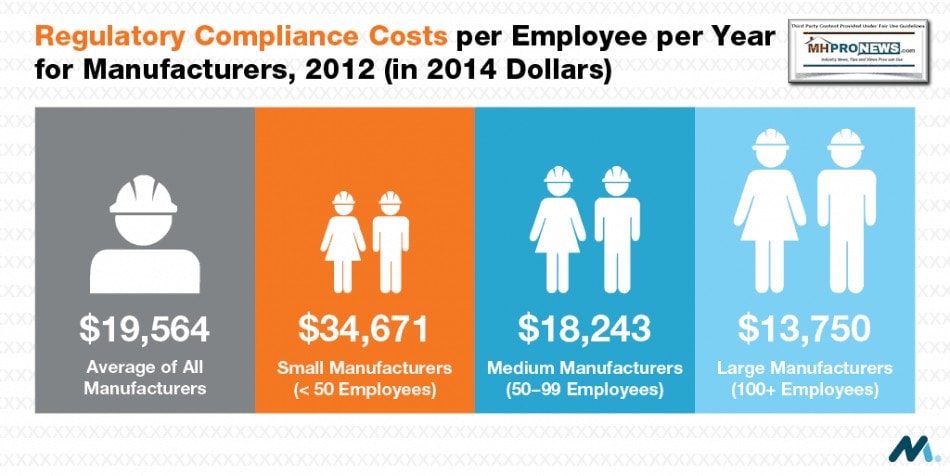
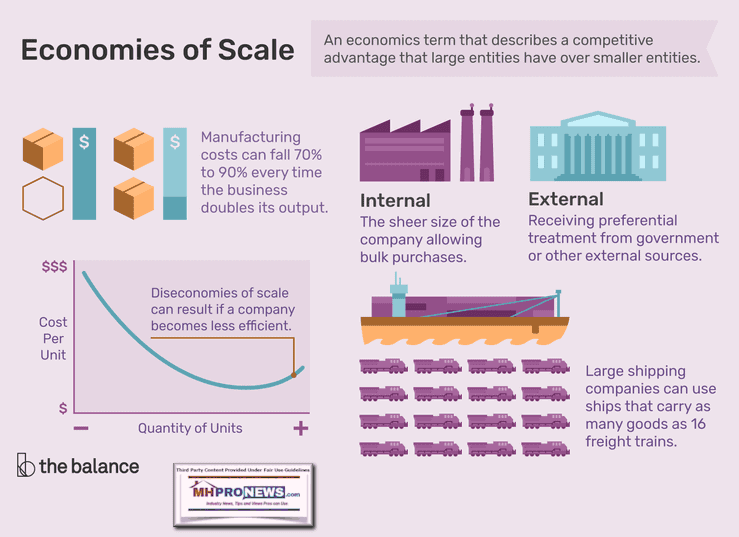
These confirm the point made and previously referenced from Carol Roth by MHProNews and others in media, but oddly avoided by others in manufactured housing trade media.


That is sufficient to tee up the press release by MHARR that follows on the looming issues that will be caused if others in the industry fail to respond to this regulatory threat that per the National Association of Home Builders could potentially results in hundreds of thousands of lost opportunities for renters to become homeowners.
Meaning, the consequences are real, disruptive, and costly for potentially millions of members of our society who may never have a chance to own a home other than a HUD Code manufactured home. That in turn means it is harmful to independently owned businesses who could otherwise sell a home to those potential homeowners, unless the pending DOE energy rule for manufactured housing is not substantively and promptly addressed.
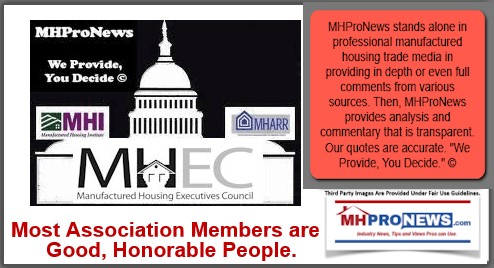
With that backdrop here is the MHARR press release, noting once again – because facts, evidence, and historic trends matters – that MHI offered no press release on this same set of topics.

SEPTEMBER 16, 2021
TO: MANUFACTURED HOUSING INDUSTRY PRODUCERS,
RETAILERS AND COMMUNITIES
FROM: MARK WEISS
RE: MHARR SUBMITS INITIAL COMMENTS ON PROPOSED
DOE MANUFACTURED HOUSING “ENERGY” STANDARDS
Attached, for your information, are initial comments submitted by the Manufactured Housing Association for Regulatory Reform (MHARR) to the federal Manufactured Housing Consensus Committee (MHCC) in connection with the MHCC’s upcoming September 23, 2021 meeting to consider – and provide comments on – the latest U.S. Department of Energy (DOE) proposed “energy conservation” standards for manufactured housing. The September 23, 2021 meeting will be the first in a series of three scheduled MHCC conference calls to address the proposed DOE standards, which were published in the Federal Register on August 26, 2021. The subsequent MHCC meetings are currently slated to be held on October 8, 2021 and October 20, 2021, just five days ahead of the current DOE comment deadline of October 25, 2021.
Given the compressed MHCC timetable necessitated by the current 60-day DOE comment deadline, MHARR’s initial comments address principally policy and cost issues arising from the DOE proposal which – like its earlier 2016 proposed manufactured housing energy standards rule – would impose destructive, unnecessary and discriminatory cost burdens on both manufactured homebuyers and the industry, with particularly damaging and disproportionate impacts on smaller industry businesses. Further comments that MHARR plans to submit in connection with the scheduled October MHCC meetings – as well as its comprehensive comments to DOE – will address other and additional aspects of the proposed rule, including technical aspects of various proposed provisions.
In light of the likely severe impacts of this proposed rule on both the industry and consumers, MHARR – again – urges all industry members to submit individual comments to both the MHCC and, even more importantly, to DOE, opposing this regulatory overreach, in advance of the comment deadline. To facilitate such comments, MHARR will continue to make its comments available to the entire industry in advance of the relevant MHCC and DOE deadlines.
The Manufactured Housing Association for Regulatory Reform is a Washington, D.C.-based national trade association representing the views and interests of independent producers of federally-regulated manufactured housing.
— 30 —
Manufactured Housing Association for Regulatory Reform (MHARR)
1331 Pennsylvania Ave N.W., Suite 512
Washington D.C. 20004
Phone: 202/783-4087
Fax: 202/783-4075
Email: MHARR@MHARRPUBLICATIONS.COM
Website: manufacturedhousingassociation.org
##
MHProNews Note: the text of that attachment referenced above is as shown below.

September 15, 2021
VIA FEDERAL EXPRESS AND ELECTRONIC SUBMISSION
Manufactured Housing Consensus Committee
C/O Home Innovation Research Labs
Administering Organization
400 Prince George’s Boulevard
Upper Marlboro, Maryland 20774
Re: Proposed Energy Conservation Standards for Manufactured Housing
Dear Members of the Manufactured Housing Consensus Committee:
The Manufactured Housing Association for Regulatory Reform (MHARR) submits the following comments in connection with the Manufactured Housing Consensus Committee’s (MHCC) consideration of a Supplemental Notice of Proposed Rulemaking (SNPR) regarding “Energy Conservation Standards for Manufactured Housing” published by the U.S. Department of Energy (DOE) in the Federal Register on August 26, 2021.[1] MHARR is a national trade association representing producers of manufactured housing subject to federal regulation pursuant to the National Manufactured Housing Construction and Safety Standards Act of 1974 (1974 Act), as amended by the Manufactured Housing Improvement Act of 2000 (2000 reform law), as well as relevant provisions of the Energy Independence and Security Act of 2007 (EISA).
I. INTRODUCTION
The following are MHARR’s initial comments regarding the August 26, 2021 DOE manufactured housing energy standards supplemental proposed rule. Because of the compressed time schedule that DOE’s sixty-day comment period for the August 26, 2021 proposed standards has effectively imposed on the Manufactured Housing Consensus Committee (MHCC) (and other stakeholders’) review, factfinding, analysis, and comment on the proposed standards, these initial comments will focus primarily on policy and cost aspects of the DOE proposal. MHARR will provide additional comments regarding technical and other aspects of the proposed standards as the MHCC review process moves forward.[2]
As MHARR has previously emphasized, the fundamental duties and responsibilities of the MHCC, as is made clear both by its composition and by its enumerated statutory functions, are not merely “technical” in nature. While an analysis of the technical merit of any proposal is an important part of the MHCC’s duties, its responsibilities extend much further, to a consideration of: (1) whether a proposal serves to advance the statutory objectives of the 2000 reform law (42 U.S.C. 5401);[3] (2) an analysis of the probable effect of the proposed standard, regulation or interpretation on the “cost of the manufactured home to the public” (42 U.S.C. 5304(e)(4));[4] and (3) whether the benefits of any such proposal outweigh its costs and likely impact on the “availability of affordable manufactured homes.” (42 U.S.C. 5401(b)(2)).
These same duties and functions, moreover, were expressly recognized by Congress in connection with manufactured housing energy standards under EISA. EISA section 413 thus specifically provides a review and comment role for the MHCC, and authorizes the MHCC to consider the impact of DOE-proposed energy standards on the purchase price of manufactured housing.[5] MHCC consideration of the current DOE proposal, therefore, involves not just an analysis of its purported technical merit, but also a balancing of whether that proposal, even if technically practicable, would produce destructive cost impacts that would override its value in connection with a type of housing that, as a matter of federal policy, is – and must remain – inherently affordable for every American and, particularly, lower and moderate-income homebuyers.
It is critical to note, moreover, in connection with these comments, that the cost burdens of federal regulation and over-regulation fall disproportionately on smaller businesses (and their consumers), including smaller HUD Code producers represented by MHARR, as well as retailers and communities. A landmark 2010 study of this issue by the U.S. Small Business Administration (SBA), found that “small businesses face an annual regulatory cost … which is 36 percent higher than the regulatory cost facing large firms Defined as firms with 500 or more employees).”[6](Emphasis added). This differential would undoubtedly be much higher today, following an additional decade-plus of ever-expanding federal regulation. In reviewing the DOE proposed rule, therefore, the MHCC should and must consider not only its likely impact on the purchase cost and availability of manufactured housing generally, but also: (1) the proposed rule’s specific potential impacts on smaller manufactured housing producers, retailers and communities; (2) the future viability and market share of those smaller, independent manufactured housing producers, retailers and communities as a consequence of disproportionately-higher regulatory burdens and costs attributable to the DOE proposed rule; and (3) the exacerbation of regulatory cost impacts on consumers as a result of further and more rapid industry consolidation – and a related loss of full and robust intra-industry competition – as a result of excessive and disproportionate cost burdens attributable to the proposed rule. MHARR will address all of these issues in its comprehensive written comments to DOE and in further comments to the MHCC, as the Committee proceeds with its scheduled review and analysis of the proposed “supplemental” rule.
For all of the reasons set forth below, therefore – and that will be detailed in further forthcoming MHARR comments in this matter – MHARR asks the MHCC to reject DOE’s proposed manufactured housing energy standards rule, in its current form, as a baseless, unnecessary attack on the availability and affordability of manufactured housing, which will needlessly exclude vast numbers of lower and moderate-income Americans from the American Dream of homeownership in order to satisfy the ideological predilections of “climate” extremists.
II. COMMENTS
A. THE MHCC SHOULD REQUEST AN IMMEDIATE
EXTENSION OF THE DOE COMMENT DEADLINE
As an initial procedural matter, MHARR urges the MHCC to request an immediate extension of the DOE written comment deadline in this matter in order to provide sufficient time for the MHCC (and other affected stakeholders) to conduct a valid, legitimate and fully-informed review and analysis of the DOE proposed rule.[7]
DOE acknowledges that its August 26, 2021 proposed manufactured housing energy rule – a rule that, to date, it has spent 14 years developing, and that has been fundamentally flawed from its inception through its current iteration — is a “significant regulatory action” as determined by the Office of Management and Budget (OMB), meaning that it will likely “Have an annual effect on the economy of $100 million or more or adversely affect in a material way the economy, a sector of the economy, productivity, competition, jobs, the environment, public health or safety, or State, local, or tribal governments or communities.”[8] Given the significant and, indeed, extreme impacts that this proposed rule would have on both the manufactured housing industry (and especially its smaller businesses) and American consumers of affordable housing, as well as the myriad of technical and related cost considerations entailed in seeking to adapt and conform a code for site-built structures to the unique construction and economic imperatives of federally-regulated manufactured housing, a 60-day comment period (punctuated by at least two federally-designated holidays) is clearly inadequate and fundamentally unfair and inequitable both to the MHCC and to other interested parties, including MHARR, that will submit comment on the proposed rule, likely including comments that reference, rely upon, or amplify comments offered by the MHCC.
While HUD has scheduled three meetings for the MHCC to consider and analyze the DOE proposed rule and prepare responsive comments, with meetings currently scheduled on September 23, 2021, October 8, 2021 and October 20, 2021[9] – just five days before the current DOE comment deadline – these meetings are based on a highly-compressed time schedule that is unlikely to provide sufficient time for thorough, proper and legitimate MHCC consideration and vetting of the DOE proposed rule from the unique perspective of manufactured housing users, producers, retailers and communities. A thorough vetting of this sort is not only authorized and, indeed, required by applicable statutes, as noted above, but is particularly necessary in this rulemaking, where DOE has repeatedly demonstrated its willingness to deceive, connive, obfuscate, distort the facts, conspire and skirt the law, with successive fundamentally flawed proposals, in order to achieve the policy objectives that it institutionally shares with climate extremists and energy special interests.[10]
There is, moreover, recent direct precedent for such an extension. On August 9, 2021, DOE published notice of an extension of the comment deadline for proposed revisions to its so-called “Process Rule” concerning updates to appliance energy standards under the Energy Policy and Conservation Act of 1975.[11]In that notice, DOE stated: “On July 29, 2021, interested parties in this matter, the Joint Commenters, requested an extension of the public comment period for the [Notice of Proposed Rulemaking] to September 13, 2021. The Joint Commenters asked for this additional time due to their assertion that the proposed rule is complex and multi-faceted, which requires more time to effectively review it and formulate their comments.”[12](Emphasis added). If anything, the present rulemaking is even more “complex and multi-faceted” than the DOE process rule because: (1) it is an entirely new proposed rule, not a mere update of an existing rule; (2) it involves and addresses construction of the entire home rather than specific discrete appliances; (3) entails statutory considerations of cost and cost-effectiveness involved in fundamentally transforming an energy code for site-built homes into standards for affordable manufactured homes, that must be completely and properly considered and evaluated in order to avoid potentially irreparable harm to manufactured housing consumers and smaller industry businesses; and (4) must be thoroughly vetted by the MHCC in light of DOE’s egregious 14-year track record of fundamentally flawed and highly-destructive manufactured housing energy proposals.
Accordingly, MHARR asks the MHCC to request a comment deadline extension from DOE for itself and all other commenters – and that it take other steps as necessary to ensure that such an extension is granted – in order to ensure: (1) that all applicable statutory guarantees are observed and honored; (2) that the MHCC can perform its essential vetting and commentary function based on full and complete information and analysis; and (3) to ensure that yet another fundamentally flawed DOE manufactured housing energy proposal is not imposed as a final rule.
B. MANUFACTURED HOME ENERGY USAGE AND COSTS
ARE ALREADY LOWER THAN OTHER TYPES OF HOMES
DOE manufactured housing “energy conservation” standards, including the August 26, 2021 proposed standards, are – and always have been – a purported “solution” in search of a problem. Notwithstanding continual efforts by DOE, climate extremists, energy special interests and others to skew, manipulate, obfuscate and distort relevant data, the fact of the matter is that HUD-regulated manufactured homes, under existing HUD manufactured housing standards for energy and energy-related functions, already offer occupants lower monthly energy costs than other types of homes. Indeed, federal government data shows that monthly manufactured housing energy costs have actually fallen further below energy costs for single-family detached site-built homes since DOE published its initial manufactured housing energy standards proposal in 2016.
In its written comments on the 2016 DOE manufactured housing energy rule, MHARR noted:
“As a consequence of … pre-existing HUD energy standards, manufactured homes, as established by U.S. Census Bureau data, are already energy efficient without regressive, high-cost DOE energy mandates. Specifically, data from the 2013 American Housing Survey shows that the median monthly housing cost for fuel oil was $92.00 for manufactured homes as compared to $267.00 for other types of housing. The median monthly cost for piped natural gas was $34.00 for manufactured homes as compared with $38.00 for other types of housing, and the median monthly cost for electricity was only slightly higher for manufactured homes (at $119.00) than other types of homes (at $105.00) – a difference of only $168.00 per year.”[13]
(Emphasis in original).
Newer data published in the 2019 American Housing Survey (AHS), however, shows that today’s modern, HUD Code manufactured homes, have lower median monthly energy costs than detached site-built homes in all fuel categories. Specifically, the 2019 AHS shows that the median monthly cost for fuel oil was $83.00 for manufactured homes, as compared with $125.00 for detached site-built homes.[14]The median monthly cost for natural gas was $40.00 for manufactured homes, as compared with $58.00 for site-built detached housing, and the median monthly cost for electricity was $122.00 for manufactured homes, as compared with $124.00 for site-built homes.[15]The median monthly fuel cost for HUD-regulated manufactured homes across all types and ages, therefore, is already up to 51% less than the monthly median fuel cost for single-family detached site-built homes.[16] Similarly, the mean monthly fuel cost for current manufactured homes, as calculated by the AHS, is also lower than the mean for single-family, detached, site-built homes with respect to monthly fuel costs. Thus, the mean monthly cost for electricity in manufactured homes is $133.00, as compared with $141.00 for detached, single-family, site-built homes, the mean monthly cost for piped gas in manufactured homes is $60.00, as compared with $73.00 for site-built homes, and the mean monthly cost for fuel oil is $88.00 in manufactured homes, as compared with $143.00 for site-built homes.[17]The mean monthly fuel cost for HUD-regulated manufactured homes across all types and all ages, therefore, is already up to 62% less than the mean monthly fuel cost for detached, single-family, site-built homes.[18]
The existing HUD manufactured housing energy standards, accordingly, ensure the energy operating affordability of manufactured homes – on a whole-home basis, as compared with site-built, single-family homes – while maintaining and preserving the overall purchase price affordability of manufactured housing in accordance with, and as required by, applicable federal law. By contrast, alleged “analyses” comparing site-built and manufactured home energy usage and energy costs on a per-square-foot basis, are irrelevant and misleading, because the average size of all manufactured homes in 2020 — again according to U.S. Census Bureau data – was 1,471 square feet, as contrasted with an average size of 2,527 square feet for a single-family site-built home, a size differential of almost 72%.[19] The MHCC, accordingly, should reject cost comparisons and analyses based on “per-square-foot” energy usage,[20] and should instead base its analyses and conclusions regarding the efficacy and affordability of manufactured housing energy standards based on “whole house” energy usage and cost comparisons. Analyzed in that manner, using authoritative data from federal sources, it is apparent and, indeed, indisputable, that manufactured homes, under existing HUD Code energy standards, are already both energy-efficient and cost-efficient from the perspective of the homeowner as required by applicable federal law.
This result is also compelled by the fact that the cost-benefit language of EISA section 413, requiring that DOE manufactured housing energy standards be based on the most recent version of the IECC, “except in cases in which the Secretary finds that the code (sic) is not cost-effective” (emphasis added), must be construed and applied consistently with the purposes, objectives and requirements of existing law, in this case, the 1974 Act as amended by the 2000 reform law.[21]Therefore, the “cost-effective” proviso of EISA section 413 must be construed and applied – consistently with the 1974 Act, as amended – to ensure that non-life-safety DOE energy standards do not result in purchase price increases to manufactured homes that would significantly impair their affordability, availability and accessibility to all Americans, or otherwise decrease homeownership in violation of 42 U.S.C. 5401.
C. THE PROPOSED DOE STANDARDS WOULD RESULT
IN CATASTROPHIC PURCHASE PRICE INCREASES
The manufactured housing market — and manufactured housing regulation — is based on purchase price affordability. This statutory and regulatory focus on initial purchase price affordability is consistent with the status of manufactured housing as “the largest source of unsubsidized affordable housing in” the United States and an “important source” of low-income homeownership, as noted by the U.S. Consumer Financial Protection Bureau (CFPB).[22]Applicable law thus recognizes that manufactured housing is uniquely price-sensitive, as its consumer base is comprised largely of lower and moderate-income purchasers. Purchase price affordability, as a result, is necessarily antecedent to – and more critical to the manufactured housing market – than so-called “life-cycle” affordability, because for potential purchasers excluded from the market altogether by excessive, regulatory-driven purchase price increases, there is no home they can afford to purchase and, therefore axiomatically, no “life-cycle.” Accordingly, the MHCC’s cost analysis of the DOE energy SNPR is crucial should focus first and foremost on its likely purchase price and purchase market impacts.
As currently constituted, the HUD manufactured housing construction and safety standards effectively maintain the purchase price affordability of manufactured homes at monthly energy operating cost levels (as demonstrated above), that are well below the comparable monthly energy operating costs of site-built homes. Current HUD standards, moreover, also ensure that the total monthly operating costs of HUD Code manufactured are significantly lower than those of site-built homes. The 2019 American Housing Survey thus documented a monthly median housing operating cost of $610.00 for manufactured homes, and $1,106.00 for single-family, detached site-built homes, a savings of nearly 58% under the current HUD manufactured housing standards. Consequently, the existing HUD Code standards –including the existing HUD Code energy standards — are consistent with the affordability and affordability balancing requirements of federal law, which ensure that manufactured homes are not only energy-efficient but are also available at a range of purchase prices that are affordable for lower and moderate-income Americans. The International Energy Conservation Code (IECC), by contrast, is subject to no similar statutory affordability or balancing mandates. As a result, it is a high-cost code, as was demonstrated initially by MHARR in 2016 with respect to the 2015 IECC and by Home Innovation Research Labs (HIRL) – the research arm of the National Association of Home Builders (NAHB)[23] – with respect to the 2021 IECC.
The 2015 IECC, which was the basis for DOE manufactured housing energy standards initially proposed in 2016[24]— as calculated by MHARR – would have resulted in retail level purchase price increases of $4,601.00 for a single-section manufactured home, and $5,825.00 for a double-section manufactured home.[25]These amounts included industry-standard builder and retailer profit margins,[26] but did not include regulatory testing, compliance or enforcement costs, which were not estimated or considered by DOE in the June 2016 rulemaking proceeding. Consistent with MHARR’s 2016 findings, a June 2021 HIRL report found that the 2021 IECC, as published, would result in a national incremental construction cost increase of $6,548.00 to $9,301.00 for a specified reference home of 2,500 square feet, depending on the compliance mechanism selected.[27]The same analysis shows a national simple construction cost payback period ranging from 32 to 67 years, again based on the compliance mechanism. Prorating these amounts to the smaller size of an “average” single-section and double-section manufactured home, as defined by the U.S. Census Bureau, and including industry-standard profit margins identical to those used in MHARR’s 2016 calculation, the 2021 IECC, in unmodified form, would yield a minimum incremental retail-level price increase of $7,958.00 for an “average” single section manufactured home and a minimum incremental retail-level price increase of $12,908.00 for an “average” double-section manufactured home.[28]And again, it must be stressed that as large as these amounts are, they are necessarily incomplete, in that: (1) they do not include regulatory testing, compliance or enforcement costs; and (2) do not include costs attributable to future changes to the IECC and the costs of compliance with such future modifications – which are, and would be, totally unnecessary for today’s modern, already energy cost-efficient, HUD Code manufactured homes.
While the August 26, 2021 DOE proposed rule does not incorporate the full 2021 IECC as to either “Tier1” or “Tier 2,” and also includes arbitrary DOE modifications to certain 2021 IECC criteria, MHARR expects that a full purchase price analysis of the DOE proposal, based on current costs for smaller, independent producers, will yield expected purchase price increases between the 2016 MHARR projected amounts and the 2021 HIRL projected amounts. Regardless of the precise amount(s), however, price increases of this magnitude – and anywhere within this potential range — within the highly cost-sensitive manufactured housing market, would be devastating to lower and moderate-income consumers who rely on the purchase price affordability of manufactured housing, in direct violation of federal law.
First, price increases of this magnitude would exclude millions of Americans from the manufactured housing market and from homeownership altogether. An NAHB analysis presented to the DOE Manufactured Housing Working Group in 2014, demonstrated that for every $1,000.00 increase in the purchase price of a single-section manufactured home, 347,901 households are excluded from the market. Similarly, for a double-section home, a $1,000.00 purchase price increase excludes 315,385 households from the market.[29]Extrapolating these amounts to the purchase price increases under the full, unmodified 2021 IECC calculated above, 2,748,417 households would be excluded from the single-section manufactured housing market (and homeownership altogether) and 4,068,466 households would be excluded from the double-section manufactured housing market.[30]In total, therefore, 6,816,883 households that could afford to purchase a manufactured home now, would be totally excluded from the market under the 2021 IECC. At a 2020 annual production level of 94,390 total homes, this degree of consumer exclusion represents a loss of more than 72 years of manufactured home production. Furthermore, for those excluded from the market altogether due to 2021 IECC-driven price increases, by definition, there would be no “life-cycle” savings whatsoever, and no payback period of any kind.
Extrapolating the same analysis to a median purchase price increase level 50% above that calculated by MHARR for the 2016 IECC, and 50% below the unmodified 2021 IECC to reflect the potential impact of DOE SNPR modifications, the corresponding purchase price increase levels would be $6,279.00 for a single-section manufactured home and $9,366.00 for a double-section manufactured home. At these amounts, more than 2,156,986 households would be excluded from the HUD Code single-section market, and more than 2,933,080 households would be excluded from the HUD Code double-section market, for a total of over 5,090,006 households, representing nearly 54 years of production at 2020 market levels.
Even with substantial modifications to the 2021 IECC, therefore, the impact of the DOE proposed rule on the manufactured housing market, manufactured housing consumers, and manufactured housing producers, retailers and communities, including most especially smaller businesses operating at lower profit margins, would be extreme and extremely destructive. Insofar as it would decimate the affordable manufactured housing market, it should and indeed, must be rejected.[31]
Second, and in addition to this excessive and disproportionate level of total market exclusion that would result from the DOE proposed rule, cost increases of this magnitude would substantially reduce the number of lower and moderate-income purchasers who could qualify to finance a manufactured home purchase. Already, at current retail price levels, the vast majority of applications for manufactured home consumer purchase loans are denied. According to a May 2021 report by the U.S. Consumer Financial Protection Bureau (CFPB),[32] only “a minority (27 percent) of consumers who applied for a loan to buy a manufactured home succeeded in obtaining financing.[33] Of those who did not obtain financing, the majority were denied…. An estimated 42 percent of all manufactured home purchase applications were denied, including 50 percent of chattel [loan] applications…. In comparison, only 7 percent of site-built [loan] applications were denied.”[34](Emphasis added). By increasing purchase price levels and corresponding cost burdens for consumers potentially remaining in the market, the number of potential manufactured housing purchasers who could qualify for consumer financing would be reduced even further, and the affordability of manufactured housing in relation to site-built and other types of housing would disappear, again in violation of existing law.
Furthermore, as the May 2021 CFPR Report emphasizes, the higher level of rejection rates within the chattel or personal property manufactured housing purchase loan sector – which will be significantly exacerbated by the proposed DOE energy standards – will disproportionately impact and harm “Hispanic white, Black and African American and American Indian and Alaska Native borrowers” who make up larger shares of [manufactured home] chattel borrowers than among … site-built loan borrowers.”[35]”This will especially be the case for “Black and African American borrowers,” who are “overrepresented in [manufactured home] chattel lending compared to site-built.[36]
In summary, then, on cost grounds alone, the IECC, modified or unmodified, is not an appropriate or legitimate code for affordable manufactured homes and cannot be made into an appropriate or legitimate code for manufactured homes through arbitrary and haphazard “modifications.” Furthermore, the IECC has been developed – including in its 2021 iteration – pursuant to a voting system that gave final authority over its provisions to state and local building code officials who are not responsible for the development of manufactured housing standards and have not been responsible for such standards since the enactment of the first federal manufactured housing standards law, nearly 50 years ago. Accordingly, the IECC is fundamentally and organically not an appropriate code for manufactured housing and cannot be transformed into one or shoehorned by DOE through changes and modifications around its periphery. Rather, the only appropriate code for manufactured housing is the HUD Code, subject to all applicable law governing its substance and development procedures.
D. DOE’S “TIER ONE” STANDARDS WOULD AFFECT ONLY A FRACTION
OF THE MARKET AND COULD BE EXCLUDED FROM A FINAL RULE
DOE, in its August 26, 2021 SNPR, attempts to paper-over these damning purchase price impacts by – at least for now — bifurcating its proposed standard into two separate “tiers.” As explained by DOE, “under the tiered proposal, two sets of standards would be established…. Tier 1 would apply to manufactured homes with a manufacturer’s retail list price of $55,000.00 or less,”[37] applying allegedly less costly and more highly-modified 2021 IECC measures to such homes. Tier 2 “would apply to manufactured homes with a manufacturer’s retail list price above $55,000.00”[38] and incorporate a broader range of more costly 2021 IECC measures. Significantly, though, DOE’s August 26, 2021 SNPR includes, as an “alternative proposal,” an “’untiered’ approach, wherein energy conservation standards for all manufactured homes would be based only on the 2021 IECC.”[39]Put differently, this means that despite all the talk of a “tiered” system, and the use of a tiered proposal to mislead and lure stakeholders, the public and the MHCC into supporting the DOE SNPR, a final rule in this matter could ultimately have no separate cost-based “tiers” at all, and subject all manufactured homes to high-cost market-crushing IECC-based energy standards. For this reason alone, the MHCC should reject the DOE proposed rule. But even assuming that the “tiered” DOE proposal is not a tactical deception that will ultimately be withdrawn and discarded, the August 26, 2021 proposed standard would still result in grievous harm to the manufactured housing market, manufactured housing consumers and the manufactured housing industry, with disproportionately destructive impacts on smaller industry producers, retailers, communities and other smaller businesses.
First, the selection of a retail list price of $55,000.00 as the demarcation line between the “Tier1” proposed standards and the much harsher and more costly “Tier 2” standards appears to be arbitrary and capricious,[40] and would subject the overwhelming majority of all manufactured homes to the “Tier 2” standards. The most recent U.S. Census Bureau data for manufactured housing, found that the “average” sales price of a single-section manufactured home in 2020, was $57,300.00.[41] Meanwhile, the “average” price of a double-section manufactured home was $108,500.00 and the “average” price of all manufactured homes was $87,000.00.[42]With material costs having increased in 2021, moreover, these amounts are likely substantially higher today. The $55,000.00 demarcation line, accordingly, was in 2020 – and is in 2021 — less than the average price of a single-section manufactured home. Single-section homes, in turn, comprise less than 45% of the total HUD Code manufactured housing market. The overwhelming majority of the HUD Code market in 2021, therefore, is comprised of homes priced in excess of $55,000.00. As a result, the more costly and burdensome “Tier 2” standards will impact the overwhelming majority of manufactured homes and manufactured housing consumers, with the devastating market consequences detailed above. Accordingly, the “two-tiered” system proposed by DOE – ostensibly to address the devastating market consequences of harsh IECC standards, even as modified by DOE – will have no such ameliorative impact.
Second, and as noted above, at current price levels, only “27 percent of consumers who applied for a loan to buy a manufactured home succeeded in obtaining financing” according to CFPB. This means, conversely, that among households actually seeking to purchase a manufactured home, some 73% of prospective purchasers were denied financing and, presumably, were unable to purchase a HUD Code home (or any home). Insofar, then as the 94,390 HUD Code homes actually purchased in 2020 represent just 27% of the 349,592 homes that potentially could have been purchased in 2020 if all such loan applications had been approved, the 73% of potential manufactured homebuyers rejected for purchase-money financing, represent additional potential sales of 255,202 homes[43]— which were not manufactured and sold in 2020 because of the unavailability of financing for lower and moderate-income consumers at those existing price levels. Obviously, then, if manufactured home purchase price levels are substantially increased by punitive and discriminatory DOE energy standards, the approval rate for HUD Code home loans (with all other factors being held equal) would fall even further, thereby further depressing sales and utilization levels that continue to run far below historic norms.
Nor do any of these cost calculations even begin to consider the likely impact of future IECC code changes. Insofar as EISA section 413 mandates continuing IECC-based standards updates, and the IECC is currently updated on a three-year schedule, future updates will require further modifications of the DOE standards which, in turn, will require engineering updates and related HUD enforcement system approvals for manufacturers, all of which will entail substantial additional costs and even further destructive market disruptions – none of which has been or will be captured by DOE’s alleged regulatory cost analysis.
Again, therefore, the regulatory structure and standards envisioned by DOE would be destructive of the manufactured housing market and would destroy the fundamental affordability of manufactured housing in violation of existing federal law.
III. CONCLUSION
For all the foregoing reasons, as well as those which will be further delineated in subsequent MHARR comments, the MHCC should reject the proposed manufactured housing energy standards set forth in DOE’s August 26, 2021 SNPR as being inappropriate for manufactured housing, excessively costly in violation of applicable law, destructive of the affordable manufactured housing market, not cost-justified, and fundamentally arbitrary, and should submit comments reflecting that rejection to DOE in advance of the existing (or any extended) comment deadline.
Sincerely,
Mark Weiss
President and CEO
cc: Hon. Jennifer Granholm
Hon. Marcia Fudge
Ms. Shalanda Young (OMB)
HUD Code Industry Producers, Retailers and Communities
Footnotes:
[1] See, 86 Federal Register, No. 163 (August 26, 2021) at p. 47744.
[2] See, however, section II. A, below, regarding a request for an extension of time for comments in response to the DOE proposed rule.
[3] The 2000 reform law provides, in relevant part, “The purposes of this title are – (1) to protect the quality, durability, safety and affordability of manufactured homes [and] (2) to facilitate the availability of affordable manufactured homes and to increase homeownership for all Americans.”
[4] The 2000 reform law provides, in relevant part, “The consensus committee, in recommending standards, regulations and interpretations … shall: *** (4) consider the probable effect of such standard on the cost of the manufactured home to the public.”
[5] 42 U.S.C. 17071 provides, in relevant part: “(a)(1) Not later than 4 years after December 19, 2007, the Secretary shall by regulation establish standards for energy efficiency in manufactured housing. (2) Standards described in paragraph (1) shall be established after— (A) notice and an opportunity for comment by manufacturers of manufactured housing and other interested parties; and (B) consultation with the Secretary of Housing and Urban Development, who may seek further counsel from the Manufactured Housing Consensus Committee. (b)(1) The energy conservation standards established under this section shall be based on the most recent version of the International Energy Conservation Code (including supplements), except in cases in which the Secretary finds that the code is not cost-effective, or a more stringent standard would be more cost-effective, based on the impact of the code on the purchase price of manufactured housing and on total life-cycle construction and operating costs.”
[6] See, U.S. Small Business Administration, “The Impact of Regulatory Costs on Small Firms,” (Nicole V. Crain and W. Mark Crain) September 2010 at p. 8: “[Regulatory] costs per employee thus appear to be at least 36 percent higher in small firms than in medium-sized and large firms. *** In large firms, these fixed costs of [regulatory] compliance are spread over a large revenue, output, and employee base, which results in lower costs per unit of output as firm size increases. This is the familiar empirical phenomenon known as economies of scale, and its impact is to provide a comparative cost advantage to large firms over small firms.” (Emphasis added).
[7] This request should have the full, express and specific support of the Department of Housing and Urban Development and its Office of Manufactured Housing Programs as the agency charged by federal law with ensuring that the purposes and objectives of federal manufactured housing law as set forth above, are carried out and achieved.
[8] DOE’s August 26, 2021 SNPR states, in relevant part: “The Administrator of the Office of Information and Regulatory Affairs (“OIRA”) in the OMB has determined that the regulatory action in this document is a significant regulatory action under section (3)(f) of E.O. 12866.” See, 86 Federal Register, supra, at p. 47822, col. 3. Section (3)(f) of Executive Order 12866, “Regulatory Planning and Review” (September 30, 1993), in turn, states that a “significant regulatory action” is one that is likely to result in a rule that may: (1) Have an annual effect on the economy of $100 million or more or adversely affect in a material way the economy, a sector of the economy, productivity, competition, jobs, the environment, public health or safety, or State, local, or tribal governments or communities; (2) Create a serious inconsistency or otherwise interfere with an action taken or planned by another agency; (3) Materially alter the budgetary impact of entitlements, grants, user fees, or loan programs or the rights and obligations of recipients thereof; or (4) Raise novel legal or policy issues arising out of legal mandates, the President’s priorities, or the principles set forth in this Executive order.”
[9] See, 86 Federal Register No. 171 (September 8, 2021) “Notice of a Federal Advisory Committee Meeting: Manufactured Housing Consensus Committee,” at p. 50369.
[10] Fully-documented details of DOE’s manipulation of this rulemaking – from its inception – are set forth in MHARR’s August 8, 2016 comments to DOE regarding the initial DOE proposed manufactured housing energy standards rule (MHARR2016 DOE Comments), which the current SNPR allegedly “supplements.” Those comments are attached hereto as Attachment 1. MHARR hereby incorporates those comments herein as if restated in full.
[11] See, 86 Federal Register No. 150 (August 9, 2021) “Extension of Public Comment Period,” at p. 43429, attached hereto as Attachment 2.
[12] Id.
[13] See, Attachment 1, supra at p. 23.
[14] See, U.S. Census Bureau, 2019 American Housing Survey, Fuel Cost Comparison Table (extract), attached hereto as Attachment 3.
[15] Id.
[16] The 2019 AHS data thus shows that the median monthly cost for electricity is 1.6% less in current HUD Code manufactured homes than in detached, single-family site-built homes, monthly piped gas costs are 45% lower in current manufactured homes, and monthly fuel oil costs are 50.6% lower in HUD-regulated manufactured homes.
[17] See, Attachment 3.
[18] The 2019 AHS data thus shows that the mean monthly cost for electricity is 6% less in current HUD Code manufactured homes than in detached, single-family site-built homes, mean monthly piped gas costs are 21.6% lower in current manufactured homes, and mean monthly fuel oil costs are 62.5% lower in HUD-regulated manufactured homes.
[19] Even limiting the size comparison to larger, double-section manufactured homes, site-built homes are still 43.5% larger.
[20] See e.g., American Council for an Energy Efficient Economy (ACEEE), “A Buildings Efficiency Agenda for 2021 – Manufactured Housing Standards” (October 2020) at p. 1: “Manufactured homes use more than $12 billion in energy each year…. The average energy cost per square foot is 70% higher than for the average single-family home.”
[21] See e.g., “Statutory Interpretation, General Principles and Recent Trends,” Congressional Research Service (December 19, 2011) at p. 29, stating: “A court ‘must read two statutes to give effect to each if it can do so.” Citing Watt v. Alaska, 451 U.S. 259 (1981).
[22] See, Consumer Financial Protection Bureau, “Manufactured Housing Finance: New Insights from the Home Mortgage Disclosure Act Data” (May 2021), pp. 8-9.
[23] See, Home Innovation Research Labs, “2021 IECC Residential Cost Effectiveness Analysis” (June 2021) (HIRL Report), attached hereto as Attachment 4.
[24] See, 81 Federal Register, No. 117 (June 17, 2016), “Energy Conservation Standards for Manufactured Housing,” at p. 39756, et seq.
[25] See, MHARR 2016 DOE Comments, at p. 15, note 42.
[26] Industry-standard builder and retailer profit margins were calculated as multiples of 2.0 and 1.4 by MHARR, based on input from smaller, independent producers.
[27] See, HIRL Report at p. 14.
[28] I.e., for a single-section home: $6,548.00/2,500 square feet = $2.619 per square foot x 1,085 square feet (for an “average” single-section manufactured home) = $2,842.00 x 2 (builder profit) = $5,684.00 x 1.4 (retailer profit) = $7,958.00 retail level price increase. For a double section home: $6,548.00/2500 square feet = $2.619 per square foot x 1,760 square feet (for an “average” double-section manufactured home) = $4,610.00 x 2 (builder profit) = $9,220.00 x 1.4 (retailer profit) = $12,908.00 retail level price increase.
[29] See, MHARR 2016 DOE Comments at p. 25.
[30] For single section manufactured homes: $7,958.00 (minimum retail price increase) x 347,901 (excluded from the market per $1,000.00 price increase) = 2,748,417 excluded. For double section manufactured homes: $12,908 (minimum retail price increase) x 315,385 (excluded from the market per $1,000.00 price increase) = 4,068,466 excluded
[31] DOE, in its August 26, 2021 SNPR, attempts to discredit NAHB’s market exclusion analysis, stating: “DOE reviewed the 2014 NAHB study referenced by MHARR and [the Alabama Manufactured Housing Association] and found the values cited by MHARR and AMHA from that study are not representative of the manufactured housing market’s prospective buyers. The NAHB study estimates the reduction in buyers assuming all American households intend to buy a home. *** Rather than analyzing all American households, DOE’s estimate in this [SNPR] calculates the number of households no longer able to purchase a manufactured home from the pool of households planning to purchase a manufactured home (which is smaller than the total number of American households).” Instead, DOE relies on a 2007 study by two academics concluding that manufactured housing consumers “are not nearly as price-sensitive” as projected, because the price of manufactured housing will still be below that of site-built housing and “low- and moderate-income families have few [other] low-cost choices for home ownership.” See, 86 Federal Register, supra at p. 47797, col.1. (Citations omitted, emphasis added). The sum total of DOE’s argument, accordingly, is: (1) they – and only they, can somehow magically divine the intent of potential home purchasers and can accurately forecast how many potential purchasers “plan” on purchasing a manufactured home, as contrasted with some other type of home; and (2) that those consumers “planning” to purchase a manufactured home will remain in the market because they have nowhere else to go for affordable housing/homeownership. These arguments are absurd on their face, and not worthy of serious consideration. First, there is absolutely no valid or legitimate empirical basis for DOE to assert who is – or is not – “planning” to purchase a manufactured home, either at current price levels or at the price levels that would result from DOE’s proposed standard. Second, DOE’s “no alternative” argument is a disgraceful corollary of “let them eat cake.” It insultingly assumes that because lower and moderate-income purchasers cannot typically afford higher-priced site-built and other types of homes, they will effectively be forced into remaining in the manufactured housing market due to the lack of alternatives. The reality of the matter, however, is that those consumers would more likely drop out of the housing market altogether and effectively be excluded from homeownership – a point that DOE would prefer to ignore.
[32] DOE admits in its August 26, 2021 SNPR that it “is aware of the 2021 CFPB report but has not yet reviewed it in detail” and, “accordingly, did not incorporate any new or additional data from the 2021 CFPB report into” its SNPR analysis. See, 86 Federal Register, supra at p. 47758, col. 1.
[33] This contrasts with a success rate of “74 percent of [loan] applications for site-built homes.” See, CFPB Report, supra at p. 4.
[34] See, CFPB Report, supra at p. 15. Chattel, or personal property manufactured home purchase loans, moreover, in 2020, represented 78% of all manufactured home placements, according to the U.S. Census Bureau.
[35] Id. at p. 31.
[36] Id.
[37] See, 86 Federal Register at pp. 47745-47746.
[38] Id. at p. 47746, col.1
[39] Id.
[40] The Administrative Procedure Act (APA) authorizes courts to invalidate, among other things, agency rules that are “arbitrary capricious, an abuse of discretion or otherwise not in accordance with law.” 5 U.S.C. 706(2)(A).
[41] See, U.S. Census Bureau, “Cost and Size Comparisons: New Manufactured Homes and New Single-Family Site-Built Homes, 2014-2020,” attached hereto as Attachment 5.
[42] DOE, in its August 26, 2021 SNPR similarly admits that it is “aware” of the existence of these figures, but “has not reviewed [them] in detail or incorporated these new data into the analysis presented” in its SNPR. See, 86 Federal Register, supra, at p. 47758, col. 2.
[43] The 2021 CFPB Report shows a manufactured home purchase loan approval rate of 27%. Assuming for present purposes that all manufactured homes purchased in 2020 were financed, the 94,390 manufactured homes purchased in 2020 are 27% of 349,592. Thus, 349,592 minus 94,390 equals 255,202 homes that could have potentially been purchased if all loan applications had been approved and represents the market loss due to current pricing levels – a market loss that will be significantly exacerbated by the high-cost DOE proposed energy standards. ##
###
Additional Information, more MHProNews Analysis and Commentary in Brief
There are several factors that sparked this revival of the DOE Energy Rule, which included the lawsuit launched by the Sierra Club, which per the sources cited in the report shown below include nonprofits tied to billionaires Warren Buffett, Chairman of Berkshire Hathaway which owns Clayton Homes and their affiliated lending, and Michael Bloomberg.

The history of this DOE energy rule reveals that MHARR, often in an authentic coalition with outside interests that saw the need to thwart this threat to affordable home ownership, essentially caused Berkshire-Clayton backed MHI to pivot after years of essentially supporting the move.


The claimed ideal of saving energy and reducing pollution, etc. is understandable. But when that ideal bumps up against the reality that it may take a decade or more to recoup the costs means that potentially millions of could be homeowners will lose that opportunity if this rule goes into effect. That’s based on research from the NAHB in their priced out study.

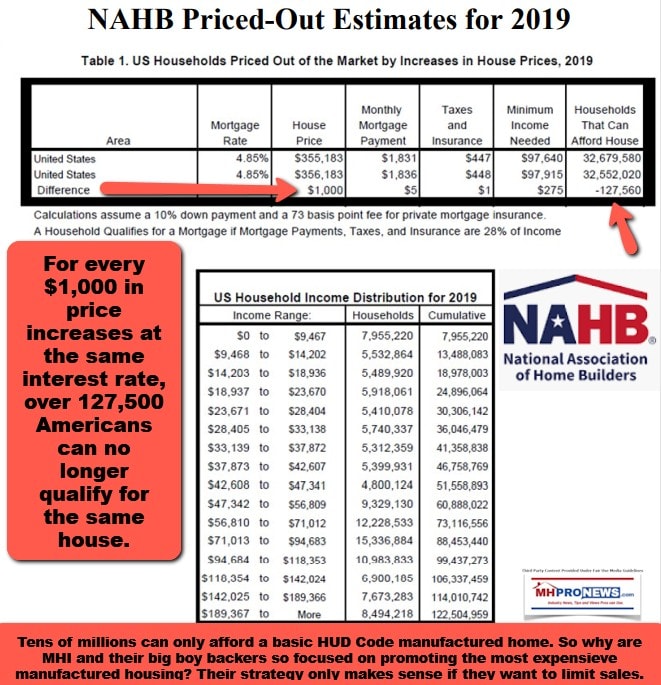
When affordable housing is in crisis, and the industry is already suffering yet another avoidable dip in production/shipments, the objective reasons to go along to get along are nil. The beneficiaries of this plan are those with deep pockets. Those harmed are independent businesses and potentially millions of Americans that may not have any other chance at home ownership.
We’ll draw to a close on this part of our business daily report with this simple call by Ayden, N.C. Mayor Pro-Tem on a different issue, but the principle he stated arguably applies.

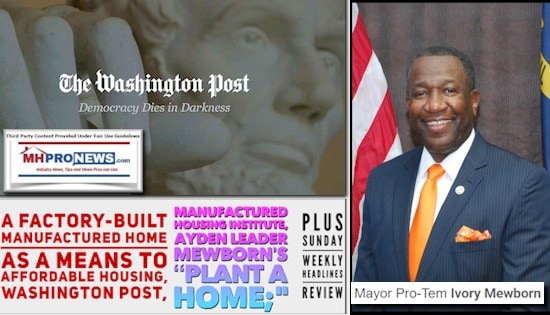
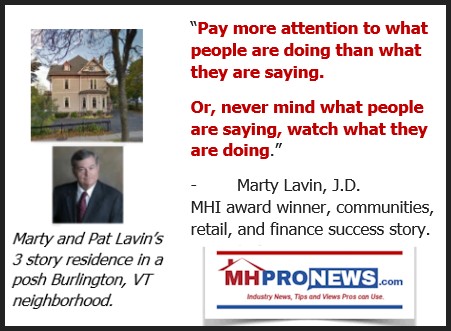
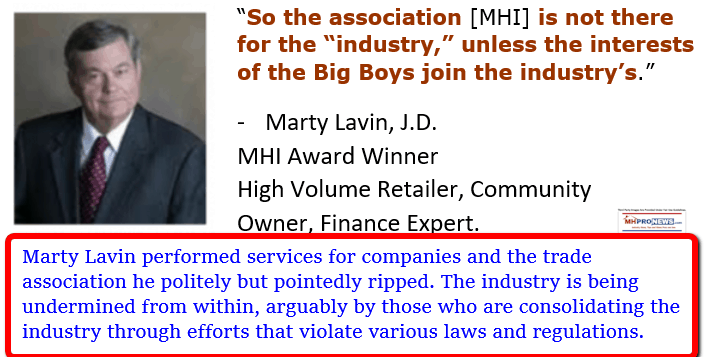
The industry’s pros are wise to push for the rejection of these “burdensome” and “costly” rules that will harm our economy that was previously recovering under the Trump-Administration’s regulatory cuts. The Biden-Harris regime’s press for job- and opportunity-killing regulations should be rejected by all industry professionals, including all those engaged at MHI. To do otherwise would only further evidence that they are working to subvert the industry who’s independents they arguably falsely claim to protect. MHARR focuses on facts and seeks to do so with some measure of diplomacy. At times the Modular Home Builders Association (MHBA) Executive Director Tom Hardiman is more blunt and less PC. Hardiman flatly accused the Biden regime as being engaged in political payoffs to their backers. Hardiman said this in connection to his analysis of the Biden-backed housing plans working their way through a Democratically dominated Congress. So, while MHARR and MHBA are seeking to defend independent producers, MHI is ‘studying’ issues from the Biden regime and conveniently failing to mention key meetings and regulations that could cripple several of the competitors of the ‘big boys’ that the evidence suggests dominate MHI.
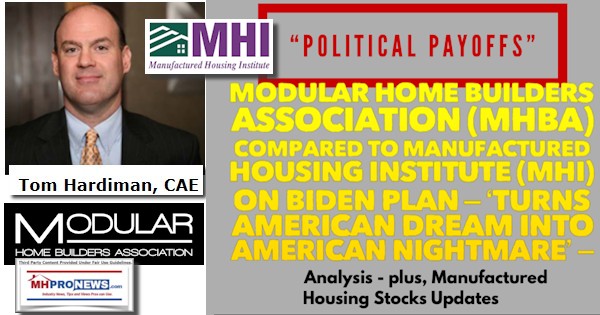
Lavin big boys The Buffett moat methods must be taken seriously. Who says? Why, Kevin Clayton, who pledged his fealty to those methods in a fashion that would make it difficult on manufactured housing competitors. The tragedy is that so many sell-outs to the consolidators in our industry who claim to be ‘trade media’ or ‘bloggers’ won’t even mention evidence of facts that run counter to the Clayton-backed MHI party line.

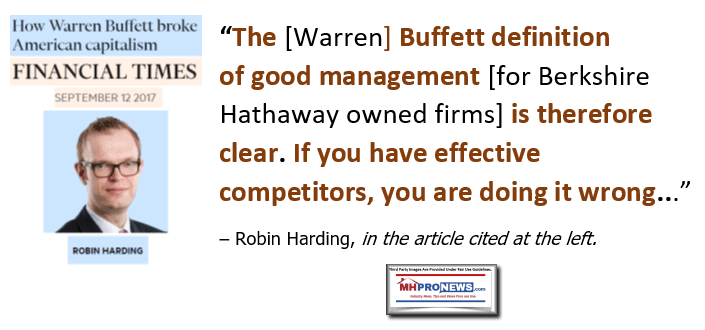
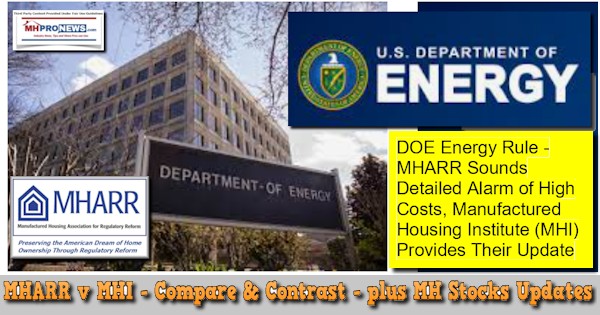

Next up is our business daily recap of yesterday evening’s market report, related left-right headlines, and manufactured housing connected equities.
The Business Daily Manufactured Home Industry Connected Stock Market Updates. Plus, Market Moving Left (CNN) – Right (Newsmax) Headlines Snapshot. While the layout of this daily business report has been evolving over time, several elements of the basic concepts used previously are still the same. For instance. The headlines that follow below can be reviewed at a glance to save time while providing insights across the left-right media divide. Additionally, those headlines often provide clues as to possible ‘market-moving’ news items.
Market Indicator Closing Summaries – Yahoo Finance Closing Tickers on MHProNews…
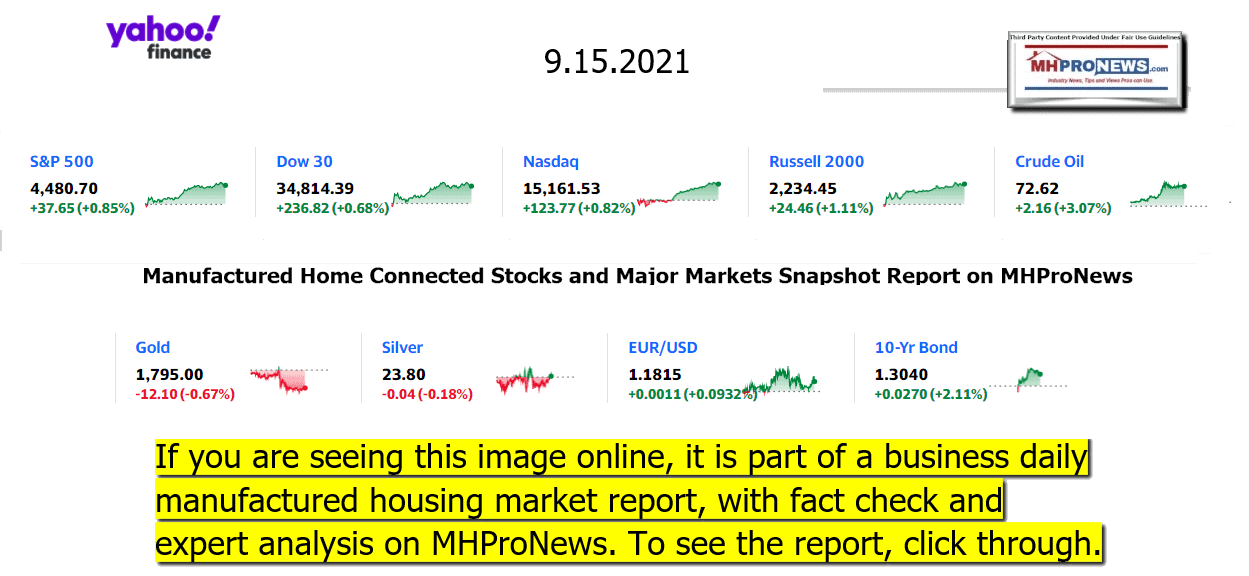
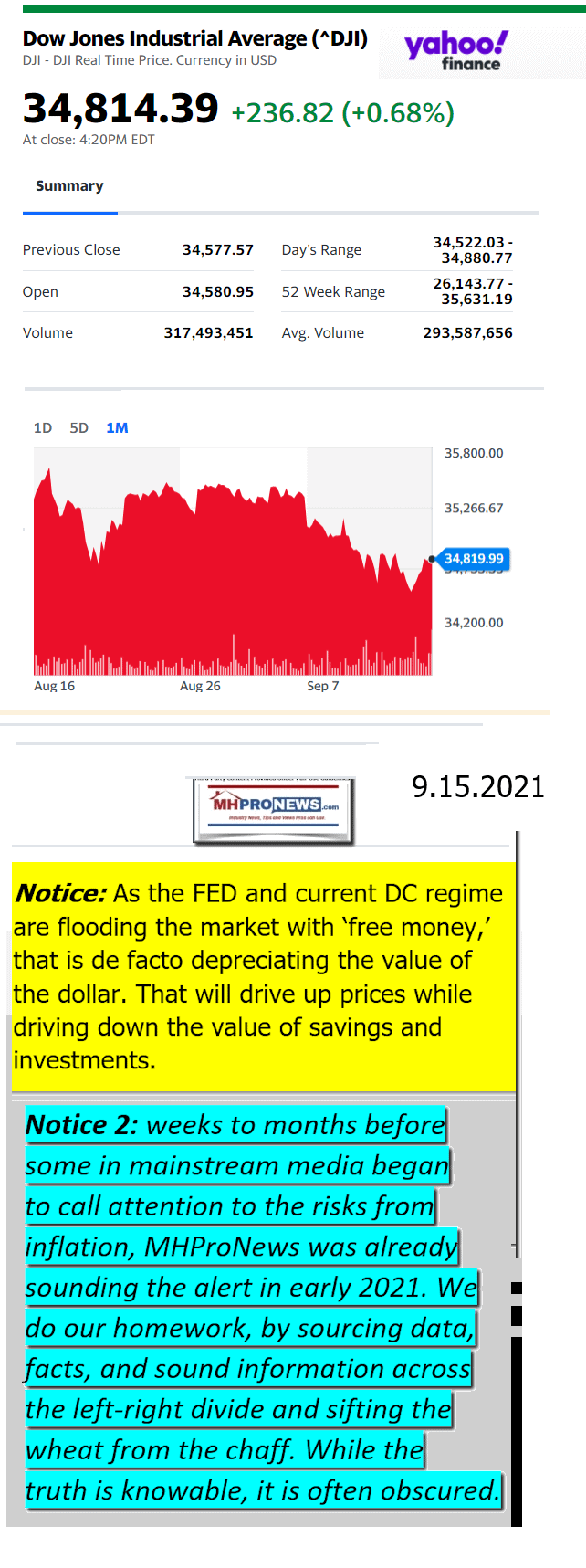
Headlines from left-of-center CNN Business – evening of 9.15.2021
- Blame Ida
- Homes destroyed in the wake of Hurricane Ida are shown in addition to a submerged automobile September 2, 2021 in Grand Isle, Louisiana. Ida made landfall August 29 as a Category 4 storm near Grand Isle, southwest of New Orleans, causing widespread power outages, flooding and massive damage.
- Car prices are about to soar again. Massive flooding is the reason
- LIVE UPDATES You can now invest in Roger Federer’s shoes
- The Delta variant has hit China’s economy hard. Now a property crunch is looming
- Casino stocks crash as Macao considers crackdown on gambling
- Chevron’s low-carbon push still puts it behind the curve
- UK inflation spikes at record rate in August
- Here’s when you can download iOS 15
- Here’s everything Apple unveiled at its big iPhone event
- See Apple’s new iPad
- US mask makers say they’re getting clobbered by cheaper competition from China
- Former Theranos employee describes being starstruck by Elizabeth Holmes
- 6 signs it’s time to quit your job
- Here’s how you can experience zero gravity without going to space
- Clubhouse has hired an NPR vet as head of news
- High stakes union election is a big boost to labor organizing in digital media
- Chris Sembroski, Dr. Sian Proctor, Jared Isaacman and Hayley Arceneaux at Kennedy Space Center on September 9, 2021.
- SpaceX will launch four space tourists on a three-day trip. Here’s everything you need to know
- NEW YORK, NY – AUGUST 25: A cart of packages waits to be delivered by a United Parcel Service employee August 25, 2021 in New York City. During the summer of coronavirus, UPS drivers are working over 12-hour shifts delivering a record number of packages while wearing masks.
- Welcome to the Delta economy: You can’t always get what you want when you want it
- In this photo illustration, a person looks at a smart phone with a Instagram logo displayed on the screen, on August 17, 2021, in Arlington, Virginia.
- Instagram says it’s working on body image issue after a report details the platform’s ‘toxic’ effect on teen girls
Headlines from right-of-center Newsmax – evening of 9.15.2021
- RNC’s Ronna McDaniel: ‘No’ to Forced Vaccines “Last week, Biden took the unconstitutional, dictatorial step of forcing vaccines on companies and families across America. This is divisive and un-American. … This authoritarian move by Biden might be the straw that breaks the camel’s back for small businesses and workers across America.” [Full Story]
- As Milley Defends Calls to the Chinese, Biden Stands By Him
- Some in Congress accused Gen. Mark Milley of having overstepped his authority and urged President Joe Biden to fire him. “I have great confidence in Gen. Milley,” Biden said when asked by a reporter whether Milley had done the right thing. [Full Story]
- Related Stories
- Rubio Calls on Biden to Fire Gen. Milley ‘Immediately’
- Trump to Newsmax: Milley’s Claims ‘Ridiculous,’ Treasonous
- Vindman, Key Trump Impeachment Witness, Says Milley Should Go
- Cotton: Let’s Hear Milley Out Before Urging Ouster
- Book: Milley Secretly Took Steps to Undermine Trump
- Newsmax TV
- Comer: Information Needed on Biden’s Call for Boosters
- Ernst: ‘Taliban 2.0’ the Same Organization It Always Was | video
- Hice: Blinken’s Testimony Proves He Needs to Resign | video
- Holt: Reports on Milley’s Actions Alarming ‘If True’ | video
- Dershowitz: Police ‘Overcharging’ Jan. 6 Capitol Rioters | video
- Trump: Bush ‘Should Apologize’ For Calling the Right Terrorists | video
- Matt Gaetz: Jan. 6 Rioters Given Unequal Treatment | video
- Blackburn: Biden Rejected Trump’s Plans for Afghanistan | video
- More Newsmax TV
- Newsfront
- Pope: Abortion Is ‘Murder,’ But US Bishops Should Not Be Political
- Pope Francis said on Wednesday that abortion is “murder,” even soon after conception, but appeared to criticize some U.S. Catholic bishops for dealing with President Joe Biden’s pro-choice position in a political rather than pastoral way…. [Full Story]
- Related Stories
- Justice Department Seeks Order Against Texas Abortion Law
- Anti-Abortion Group Cannot Enforce New Texas Law, Judge Rules
- Progressives’ Woke Terminology ‘Muddies’ Democrat Attacks on Texas Abortion Law
- Pope Rails Against Vaccine ‘Denier’ Cardinals
- Milley Defends Calls to Chinese as Effort to Avoid Conflict
- The top U.S. military officer on Wednesday defended the phone calls [Full Story]
- Pope Criticizes Politicization of Cross
- Pope Francis this week criticized the use of the Christian cross for [Full Story]
- Roger Stone: Saturday’s Capitol Rally an ‘Agitprop, Setup’
- Roger Stone is warning the Saturday “Justice for J6” rally at [Full Story] | video
- 4 Arrested in Southern California Theft Operation of 43 Retail Stores
- Four people were arrested by California Highway Patrol officers on [Full Story]
- Trump’s Legacy: Abraham Accords ‘Biggest Breakthrough Between Arabs, Jews in 25 Years’
- Ambassadors from the United Arab Emirates, Bahrain, and Israel could [Full Story] | platinum
- Lennon Interview to Schoolboys, Songs, to Auction in Denmark
- Half a century ago, four Danish teenagers interviewed John Lennon for [Full Story]
- Hurricane Ida, Supply Constraints Hold Back US Factory Production
- Production at U.S. factories slowed sharply in August as Hurricane [Full Story]
- Progressives’ Woke Terminology ‘Muddies’ Democrat Attacks on Texas Abortion Law
- Democrats are united in their goal of striking down a new Texas law [Full Story] | platinum
- Biden Admin, House Dems Taking Strong Stance With Tesla
- President Joe Biden’s administration has taken several steps to [Full Story]
- Facebook Not Sharing Data on Instagram’s Mental Health Dangers
- Facebook has been conducting studies of its Instagram platform for [Full Story]
- Conservative Group Seeks Ethics Probe Against AOC for Accepting Met Gala Tickets
- A conservative group has requested that the Office of Congressional [Full Story]
- Report: Gangs Operate Within LA County Sheriff’s Department
- At least four gangs operate and recruit within the Los Angeles County [Full Story]
- Jake Bequette: Joe Biden Must Be Held Accountable
- One thing has become crystal clear: Joe Biden is a disgrace. [Full Story]
- Seniors Everywhere Should Wear This $49 Fit Watch
- Koretrak
- Biden Rejected Recommendations From Blinken, Lloyd to Withdraw Gradually From Afghanistan
- President Joe Biden rejected recommendations from Secretary of State [Full Story]
- Biles Tells Congress ‘Enough Is Enough’ After Gymnast Abuse
- Olympic gold medalist Simone Biles told Congress on Wednesday that [Full Story]
- Building Mars Bases to Require Astronauts’ Blood, Sweat, Tears
- Building bases on Mars will literally require blood, sweat, and tears [Full Story]
- Nashville, Las Vegas Lead Top Cities for Country Music
- Nashville is the undisputed leader as the best city for country music [Full Story]
- British PM Johnson Demotes Foreign Minister in Major Reshuffle
- British Prime Minister Boris Johnson demoted his foreign secretary on [Full Story]
- McLaughlin Poll: Biden Numbers ‘Crater,’ US Worried, Kamala Not Liked
- These polls suggest American voters will be anxious to render their [Full Story]
- Dem Gov. Newsom Defeats California Recall Effort
- Dem Gov. Newsom Defeats California Recall Effort
- California Gov. Gavin Newsom on Tuesday emphatically defeated a [Full Story]
- Biden to Meet with Manchin, Sinema to Discuss $3.5T Dem Spending Bill
- President Joe Biden will meet separately with moderate Democratic [Full Story]
- High Steel Prices Challenging Manufacturers, Consumers
- Steel and aluminum prices are at their highest levels in years, [Full Story]
- Pope Rejects German Archbishop’s Resignation Over Abuse
- Pope Francis has rejected the resignation of the archbishop of [Full Story]
- Taiwan Drills Military as Fears of China Attack, Invasion Grow
- The F-16 screeched across the sky Wednesday before landing on a [Full Story]
- Biden Denies China’s Xi Turned Down Meeting Offer
- President Joe Biden denied on Tuesday a media report that his Chinese [Full Story]
- Hong Kong Security Chief Steps Up Crackdown on Remaining Independent Writers
- Hong Kong’s security chief called on Wednesday for the city’s main [Full Story]
- Treasury Releases Remaining $13B Emergency Rent Assistance Money
- The United States Treasury announced Tuesday that it was releasing [Full Story]
- Fauci Responds to Nicki Minaj’s Concern, Says Vaccines Don’t Cause Impotence
- President Joe Biden’s chief medical adviser, Dr. Anthony Fauci, [Full Story]
- Pope Urges Compassion as He Wraps Slovakia Pilgrimage
- Pope Francis urged Slovakians on Wednesday to look out for the [Full Story]
- Justice Department Seeks Order Against Texas Abortion Law
- The Justice Department has asked a federal court in Texas to stop the [Full Story]
- Incredible Miniature Telescope Lets You See for Miles
- Starscope
- More Newsfront
- Finance
- Apple Fanfare Over iPhones, Watch, AirPods
- Apple will hold its annual iPhone launch event on Tuesday, according to reports. Analysts expect Apple will unveil new iPhones with 5G connectivity and a more squared-off look; a brand-new Apple Watch with 16I% more pixels and a blood-pressure sensor; and AirPods. [Full Story]
- Banking Regulators Working on Climate Risk Management Guidance
- Shareholder Support for U.S. Climate Measures Hits Nearly 50% -report
- FDA Strikes Neutral Tone Ahead of Vaccine Booster Meeting
- DoorDash Sues NYC Over Rights to Customer Data
- More Finance
- Health
- Multigenerational Study Links ADHD to Dementia Risk
- Attention-deficit/hyperactivity disorder (ADHD) appears to be somehow linked to risk of dementia and Alzheimer’s disease, a new multigenerational study has found. Parents and grandparents of people with ADHD have a higher risk of Alzheimer’s and dementia than people with no… [Full Story]
- 1 in 500 Americans Have Died of COVID-19
- COVID Vaccines for Kids Under 12 Could Come This Fall: Fauci
- People Synchronize Heart Rates While Listening to Stories
- Even A Third-Degree Relative With Colon Cancer Raises Your Risk: Study
Manufactured Housing Industry Investments Connected Equities Closing Tickers
Some of these firms invest in manufactured housing, or are otherwise connected, but may do other forms of investing or business activities too.
-
-
-
-
-
-
-
-
-
-
-
-
- NOTE: The chart below includes the Canadian stock, ECN, which purchased Triad Financial Services, a manufactured home industry lender
- NOTE: Drew changed its name and trading symbol at the end of 2016 to Lippert (LCII).
- NOTE: Deer Valley was largely taken private, say company insiders in a message to MHProNews on 12.15.2020, but there are still some outstanding shares of the stock from the days when it was a publicly traded firm. Thus, there is still periodic activity on DVLY.
-
-
-
-
-
-
-
-
-
-
-
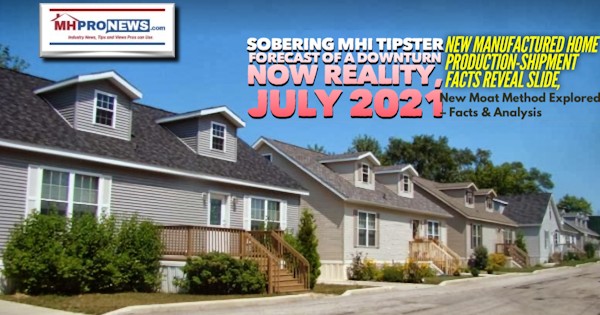
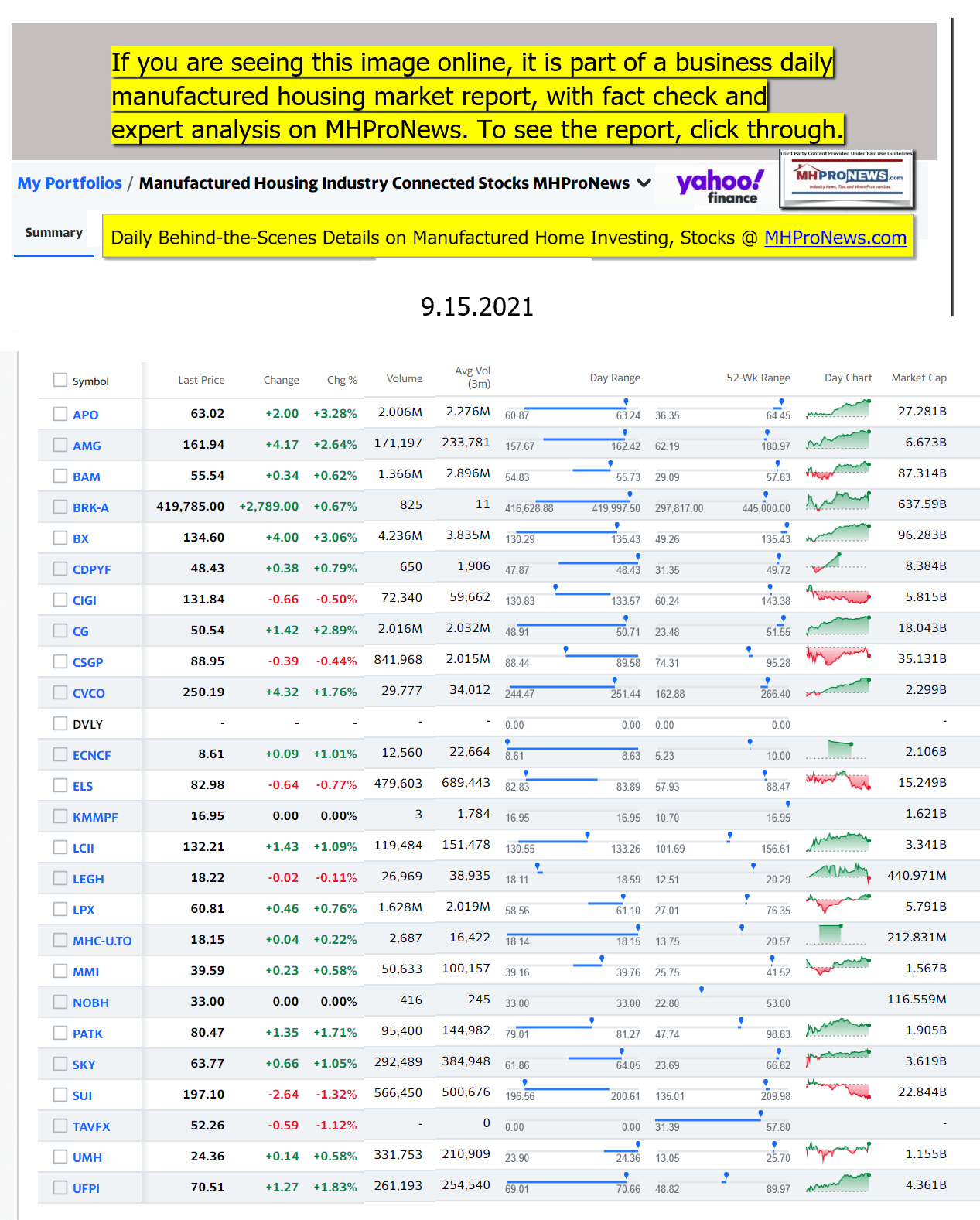
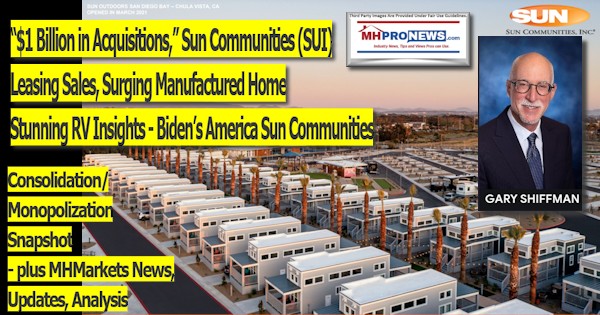

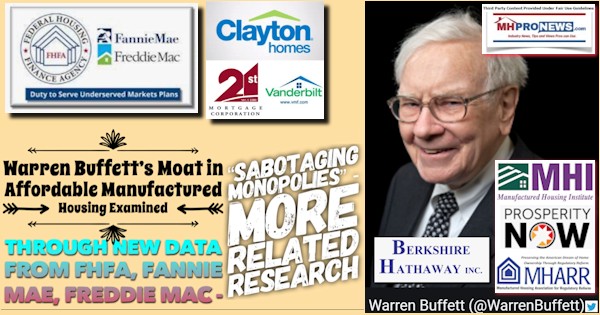


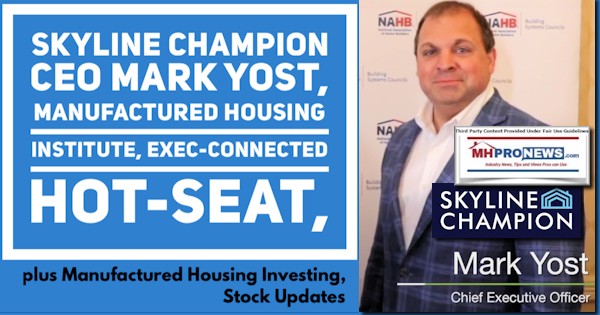
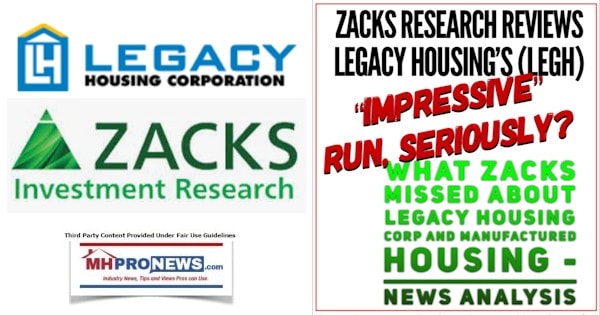
Summer 2021…
Berkshire Hathaway is the parent company to Clayton Homes, 21st Mortgage, Vanderbilt Mortgage and other factory built housing industry suppliers.
· LCI Industries, Patrick, UFPI, and LP each are suppliers to the manufactured housing industry, among others.
· AMG, CG, and TAVFX have investments in manufactured housing related businesses. For insights from third-parties and clients about our publisher, click here.
Enjoy these ‘blast from the past’ comments.
MHProNews. MHProNews – previously a.k.a. MHMSM.com – has celebrated our 11th year of publishing, and is starting our 12th year of serving the industry as the runaway most-read trade media.
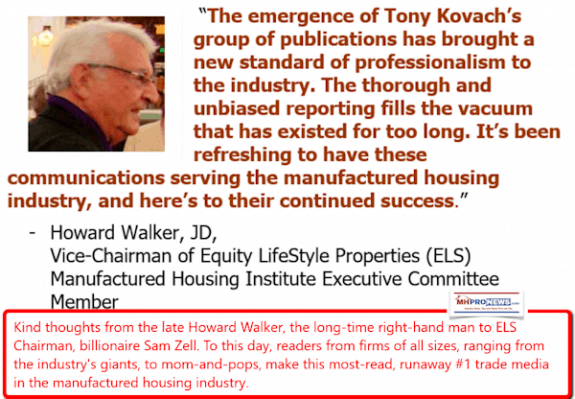
Sample Kudos over the years…
It is now 11+ years and counting…
Learn more about our evolutionary journey as the industry’s leading trade media, at the report linked below.
· For expert manufactured housing business development or other professional services, click here.
· To sign up in seconds for our industry leading emailed headline news updates, click here.
Disclosure. MHProNews holds no positions in the stocks in this report.
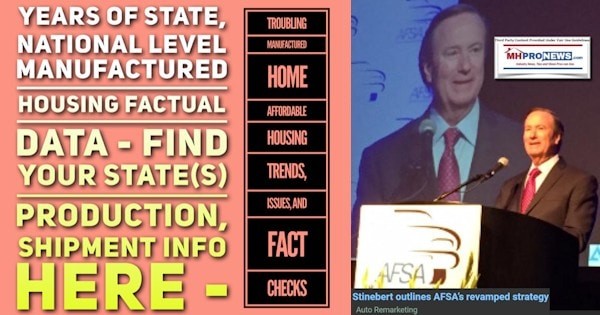



That’s a wrap on this installment of “News Through the Lens of Manufactured Homes and Factory-Built Housing” © where “We Provide, You Decide.” © (Affordable housing, manufactured homes, stock, investing, data, metrics, reports, fact-checks, analysis, and commentary. Third-party images or content are provided under fair use guidelines for media.) (See Related Reports, further below. Text/image boxes often are hot-linked to other reports that can be access by clicking on them.)

By L.A. “Tony” Kovach – for MHProNews.
Tony earned a journalism scholarship along with numerous awards in history. There have been several awards and honors and also recognition in manufactured housing. For example, he earned the prestigious Lottinville Award in history from the University of Oklahoma, where he studied history and business management. He’s a managing member and co-founder of LifeStyle Factory Homes, LLC, the parent company to MHProNews, and MHLivingNews.com. This article reflects the LLC’s and/or the writer’s position, and may or may not reflect the views of sponsors or supporters.



